ISP 205, Section 3, Spring 1997 Hufnagel & Stein
UNIT IV: THE UNIVERSE
OUTLINE
-
 A. Our Galaxy, The Milky Way
A. Our Galaxy, The Milky Way
 B. Galaxies, Normal & Peculiar
B. Galaxies, Normal & Peculiar
 C. Observations of the Universe
C. Observations of the Universe
 D. Evolution of the Universe
D. Evolution of the Universe
 E. Formation of the Universe
E. Formation of the Universe
 F. Fate of the Universe
F. Fate of the Universe
-
- What do other nearby galaxies look like?
- Mostly they come in 3 types:
- Irregulars - Magellanic Clouds [BE 3052,3055]
- Spirals - Andromeda [Be 2723, 2727]
- Ellipticals - companions to Andromeda
- Note: color of stars, dust, globular clusters
- Which type is the Milky Way?
- 1. Recognition of the Nature of the Milky Way
- a. Band of Light across the sky - Thin Disk of Stars [BE 2659]
- b. Star distribution - sun near center
"Kapteyn Universe" of 1922 [Fig 3-16]
- c. Globular Cluster distribution
- BE 1963,1965,1966,1967,1968]
- spherical distribution, diameter 105 LY, centered off to one side
- Sun =3x104 LY from center of Galaxy
- d. Interstellar dust - obscures distant stars
- e. Island Universe vs. One of Many Galaxies
- 2. Components of the Milky Way
- a. Disk
- Stars of 0-10 billion-years old, includes Open (galactic) clusters.
[Visible Light BE 2659]
- Clouds of dust. (IR shows dust BE 2669)
- Clouds of gas. [Radio: neutral hydrogen BE 2661, cold H2 BE 2664]
- Orbits nearly circular, lie in common plane.[BE 2686]
-
- (Similar to planets in solar system.)
- Spiral Arms
-
- Overhead view [BE 2650-2652], "Exploded" Structure [Fig 21-16]
- Apparent in
-
- massive, young, blue, main sequence stars
(not intermediate age stars like the Sun),
- Massive stars have such short lives,
don't have time to move from their birth place.
- H gas distribution - radio observations
- Birthplace of Stars
- Density Wave Theory
-
- spiral arms are compression waves that move through galaxy gathering stars and clouds.
- "Disk in a Dishpan" demo showing disk stars move like a fluid
- Rotation curve shows the speed of gas depends on place in disk. [Fig. 20-6]
- b. Spherical Component
- i. Halo
- Old (10-18 Billion years) Stars, mostly red giants and red MS stars.
- Globular Clusters. (Little gas or dust.) [Andromeda: BE 2726]
- Orbits elongated ellipses, randomly oriented.
(Similar to comets in solar system.)
- ii. Nuclear Bulge (flattened spheroid)
- Bulge at center of Galaxy [in direction of Sagittarius: BE 2686].
- Old and young stars.
- Hot Gas and Dust.
- iii. Center of Galaxy
- High velocity clouds of hot gas
- 5x105 MSun within 10 AU. Black hole?
- [BE 2585,2589,2602]
- c. Companion Galaxies
Magellanic Clouds, dwarf spheroidals
- Diagram of Milky Way
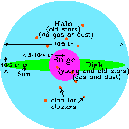

- 4. Mass of the Milky Way
- Kepler's Law M=D3 / P2
- Rotation curve
- M(R)=V2R/G
- 5. Formation Models
- Must explain the structure and ages of components
- 1. Classification by Shape (Morphology)
- a. Spirals (~15%) Spiral #8 from HST DEEP
- i. Disk
-
- Young stars, gas and dust
- Rotates
- ii. Spherical component - Halo and Nucleus
-
- Old stars, no gas or dust
- S0 galaxies - unusual variety of spiral
- i. Disk - Old stars, no gas or dust
- ii. Spherical component - Nucleus and Halo
- b. Ellipticals (~70%)Elliptical #0 from HST DEEP
- Spherical component - Nucleus and Halo
- Old stars, no gas or dust
- No disk. Some rotate.
- c. Irregular galaxies - like Milky Way's Magellanic Clouds
- d. Unusual Galaxies
- look like one of the 3 types above, but disturbed
- Chain or Merging #39 from HST DEEP
- 2. Classification by Spectra
- a. Normal galaxies (~95%)
- stellar spectrum - absorption lines in continuous spectrum
- b. Active galaxies (~5%)
- non-thermal emission
- i. Radio Galaxies
-
- Excess radio emission.
- Synchotron radiation from very fast electrons
moving through a magnetic field
- Double lobed large emission regions.
Often connected to galaxy by jets.
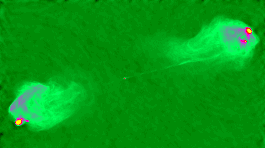
- ii. Quasars
-
- Broad emission lines. Large redshift -> large distance.
None close.
- Bright yet far away -> very luminous. Source of energy?
- Brightness varies in time of hours -> small size
(= solar system)
-
Quasars are in galaxies
- c. Center of Milky Way
- Radio emission
- Broad emission lines -> high speed (orbital or thermal) ->
high mass (= 10^6 Msun in size of solar system)
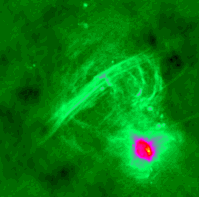
- d. Model
- Need large amount of energy
- Only source is Gravitational Potential Energy of
supermassive Black Hole
- Gas falls in, gets very hot, emits energetic photons,
Rotates rapidly, collimates jets
- 3. Large Scale Distribution
- Clusters of galaxies.
- Spirals found mostly in field, small groups, and
outer regions of clusters.
- Ellipticals and S0 dominate in centers of rich clusters.
- Galaxies distributed as on surfaces of intersecting bubbles.
- Most galaxies on arcs where bubble surfaces intersect,
- Next most galaxies on bubble surfaces (sheets),
- Fewest galaxies in interior of bubbles (voids).
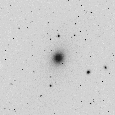 Virgo Cluster
Virgo Cluster
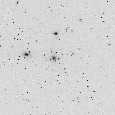 Coma Cluster
Coma Cluster
- HST DEEP
Field is a sample of galaxies back to 1 billion years after
the big bang from HST. Section of sky about as big as the period
after this sentence.
-
Interactive HST DEEP Field
Same galaxies back to 1 billion years after the big bang from HST
with information on individual galaxies available by clicking
on them.
- 4. Formation
- Clues:
- different orbits of old and young stars
- current interactions with satellite galaxies
- 1. Theory 1: Top Down [Fig. 20-29]
- Largest mass clouds collapse first -> clusters of galaxies.
- Fragment into galaxies.
- Stars formed during contraction have elongated, spherically
distributed orbits.
- As gas contracts, rotates, forms disk. Stars formed from
the disk have disk-shaped orbits.
- 2. Theory 2: Bottom up
- Globular cluster mass clouds collapse first.
- Gravitationally cluster into larger and larger hierarchies
to form galaxies and clusters of galaxies.
- Tests
- Observations indicate may need both theories
- New observations still coming in....
- e.g., is the fate of the Milky Way to merge with Andromeda?
>Simulation of Merger
- 1. Fair sample
- Universe is uniform and isotropic
- When look out in space are looking back in time, takes time
for light to travel from far away to us
- 2. Expansion of Universe
- All but nearest galaxies are red shifted - moving away from us
(Doppler shift)
- Universe is Expanding
- Hubble Law
-
- Velocity = Hubble constant x Distance
- Determining the Hubble constant
-
- measuring velocities: Doppler shift
- measuring distances:
-
- parallax
- cluster main sequences
- Cepheid variables
-
-
Cepheid Variables in M100 from HST
- globular clusters
- HII regions
- brightest galaxies in clusters
-
- Age of Universe
-
- V = D/t = H D or D = Vt = V/H
- H = 1/t
- Farther away, moving away faster, took same time
to get there
- Implication: everything started from same place at
same time
- t(age) = 1/H (must be careful of units)
- Original Hubble distances 10 x too small.
Found age ~ 2 billion years. Less than age of
oldest rocks on Earth.
- Current distance scale 10 x larger,
age 15-20 billion years.
- No center to universe
-
- Demo: blowing up balloon, stretching rubber band
- Scale of the Universe
- if Milky Way is size of earth, then distance to horizon is 17 AU
(size of Uranus orbit)
- 3. Night sky is dark
- Olber's paradox
- If look out, line of sight should eventually hit a star
-
- Like looking through forest - eventually blocked by a tree
- Sky should be as bright as surface of star. Why isn't it?
-
- Universe has only existed for finite time
- Can't see far enough away to be blocked by star
- Universe is expanding
- Light from distant stars is red shifted to very low
energy
- 1. Steady State Model
- Problem: Earth can't be older than universe.
-
- expansion age originally determined by Hubble
was 2 billion years,
- age of oldest rocks on earth is 3.5 billion years.
- Solution: Universe has existed forever. Average properties
of the universe do not change.
- Galaxies move apart, new hydrogen atoms form to fill space,
condense into new galaxies.
- Developed theory of heavy element formation in stars.
- Disproved, but was productive
- Prediction: universe does not change
- Test: Quasars seen only long ago (far away).
- 2. Big Bang Model
- Expansion -> cooling.
-
- In the past, matter and radiation were hotter and denser.
- Scenario
-
-
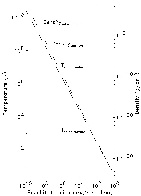
- Era of Equilibrium
-
- Very hot. All nuclear reactions very fast.
- Photons have enormous energy, destroy nuclei.
Too hot for nuclei.
- Era of Primordial Nucleosynthesis, 3 min < t < 30 min:
-
- 109 > T > 107 K.
- Cool enough for nuclei (photons have too little
energy to destroy nuclei),
- Fuse protons and neutrons -> deuterium and helium.
- Scale of universe = 10-9 to 10-7 present
- Era of Radiation, 30 min < t < million years:
-
- Too cold for fusion, too hot for atoms.
- Free electrons, protons, helium nuclei and photons.
- Universe opaque.
- Recombination, Decoupling, t = million years:
-
- T = 3000 K
- Cool enough for atoms. Electrons and nuclei combine.
- Universe becomes transparent.
- Matter and radiation no longer in thermal
equilibrium with each other
- Scale of universe = 10-3 present
- Era of galaxies, t > million years:
-
- Clouds of hydrogen and helium gas contract
to form galaxies.
- Predictions:
-
- photons from when universe was hot
- helium and deuterium from primordial nucleosynthesis
- 3. Tests: relics of the big bang
- (i) 3 K Background Radiation - photons reaching us from when universe became transparent
-
- a. Existence of 3 K background radiation means universe
was once hot.
- b. Present temperature allows us to calculate temperature
of early universe.
- c. Uniformity of background radiation shows universe was
very uniform.
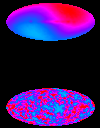 Cobe Results
Cobe Results
- d. Determine our motion through universe
- (ii) Helium and Deuterium
- 1. Problems with the Big Bang
-
- a. Why Hot?
- b. Why so uniform - 3 K radiation?
- c. Why nearly flat?
- d. Origin of irregularities that become stars and galaxies?
- 2. Solution -- Inflation
-
- Very early universe (Equilibrium Era) expanded enormously
- smooths out fluctuations, flattens space-time.
- 3. Singularity?
-
- Infinite density, singularity, at beginning of universe
implies gravity so strong quantum effects important
- Classically: either existed forever, or else began in singularity
- Quantum mechanics: possible for space-time to be finite,
but have no boundary, no singularity
- Example: Vertex of cone (origin of time) vs. N pole on sphere
(not a special location)
- Time just like spatial coordinates, if beginning of time
rounded like sphere then not a special point
- Implication: universe self-contained, Not created or destroyed.
Just is.
- 1. Expansion velocity vs. Escape velocity
- Is universe expanding fast enough to continue forever, or will
gravitational attraction of all matter for each other slow it
down enough to bring expansion to halt and start universe
recontracting?
- How determine Fate of universe?
-
- Measure Expansion Velocity
-
- Determine Hubble Constant, H
-
Recent Hubble Space Telescope Results
- Measure Escape Velocity (strength of gravity)
-
- a. measuring mass density
- galaxies -> expansion velocity =
10 x escape velocity
- clusters of galaxies -> expansion velocity
= 3 x escape velocity
- b. measuring the deceleration due to gravity
number density of galaxies as a function of
expansion velocity -> expansion velocity = escape velocity
- c. deuterium abundance depends on density of matter
-> expansion velocity = 3 x escape velocity
- 2. Geometry of the Universe
- a. If expansion velocity > escape velocity
-
- Universe will expand forever
- Universe is infinite
- Universe has saddle like geometry
- b. If expansion velocity = escape velocity
-
- Universe will expand forever
- Universe is infinite
- Universe has flat geometry
- c. If expansion velocity < escape velocity
-
- Universe will stop expanding, and contract
- Universe is finite, but has no boundary
- Universe has sphere like geometry
- 3. A Detailed Prediction of Fate of the Universe under 2.(a) or 2.(b) Geometry
- a. 100-4 billion years: Radiation-Dominated Era
-
- assumes the Big Bang Formation Scenario as above
- Ends at Recombination
- b. 106-14 billion years: Stelliferous Era
-
- Galaxies (groups of stars) are the building blocks of the Universe
- Most star formation occurs when galaxies collide, which is
common
- We are now at 1010.2
- Ends when no new stars form
- c. 1015-37 billion years: Degenerate Era
-
- all that's left is remnants
from stars are black holes, white dwarfs, neutron stars,
planets and failed stars
from galaxies with super-massive black holes, only the black hole
- Ends when the protons decay and destroy everyything with protons
- d. 1038-100 billion years: Black Hole Era
-
- only black holes, as they have no protons
- Ends when the black holes evaporate via Hawking radiation
- e. 10100+ billion years: Dark Era
-
- photons (low-energy), electrons, postitrons, neutrinos
- never ends
- [American Scientist, May-June 1997, pp 223-225]
- [Laughlin et al., Reviews of Modern Physics, April 1997]
"To doubt everything or to believe everything are two equally convenient solutions:
both dispense with the necessity of reflection."
- Henri Poincare' (1854-1912)
Links to other Galaxy and Cosmology resources
-
 mpeg movies of interacting galaxies
mpeg movies of interacting galaxies
 Hubble Space Telescope DEEP Field: Interactive Mode
Hubble Space Telescope DEEP Field: Interactive Mode
 Collision of Milky Way and Andromeda
Collision of Milky Way and Andromeda
 Galaxies from Univ. Alabama
Galaxies from Univ. Alabama
 Cosmic
Background Radiation
Cosmic
Background Radiation
This page will be updated continually throughout the course.
Updated: 1997.04.21 (Monday) 12:24:26 EDT
This page has been accessed
times.
 Visions of the Universe
Visions of the Universe
Beth Hufnagel's
home page, email:
bhufnage4@pilot.msu.edu
Bob Stein's
home page, email:
steinr@pilot.msu.edu
 A. Our Galaxy, The Milky Way
A. Our Galaxy, The Milky Way
 B. Galaxies, Normal & Peculiar
B. Galaxies, Normal & Peculiar
 C. Observations of the Universe
C. Observations of the Universe
 D. Evolution of the Universe
D. Evolution of the Universe
 E. Formation of the Universe
E. Formation of the Universe
 F. Fate of the Universe
F. Fate of the Universe


 Virgo Cluster
Virgo Cluster
 Coma Cluster
Coma Cluster
 Cobe Results
Cobe Results